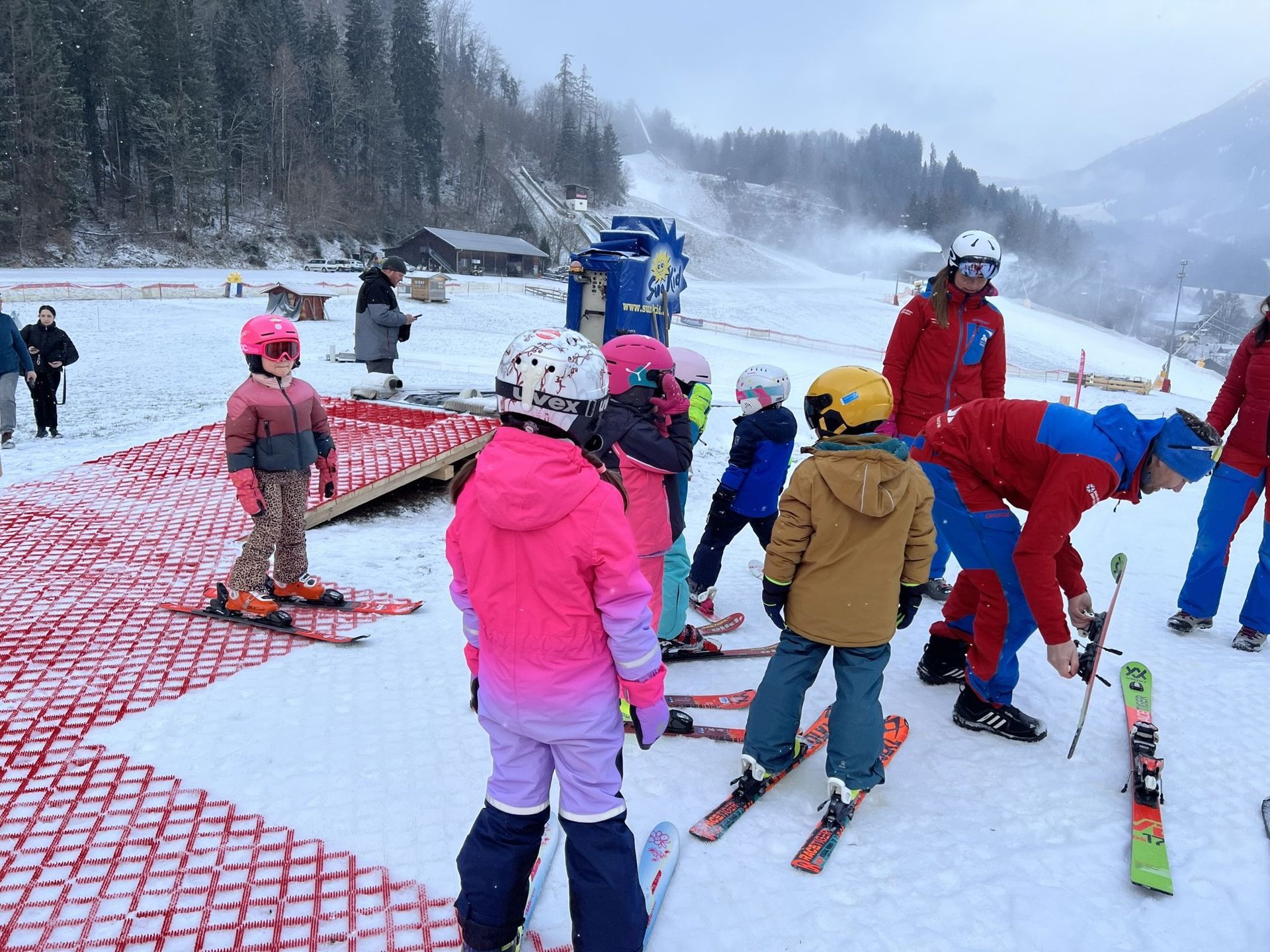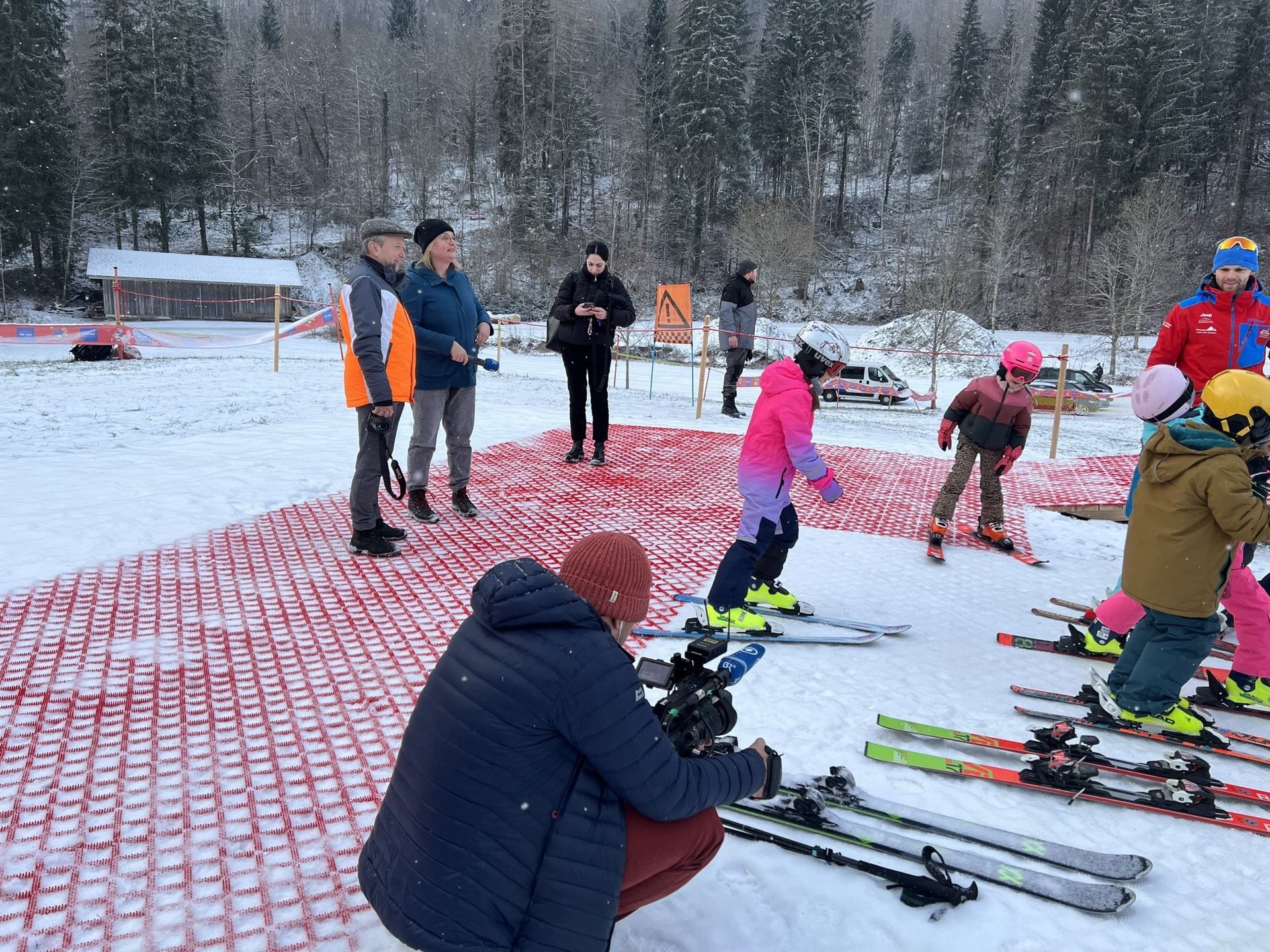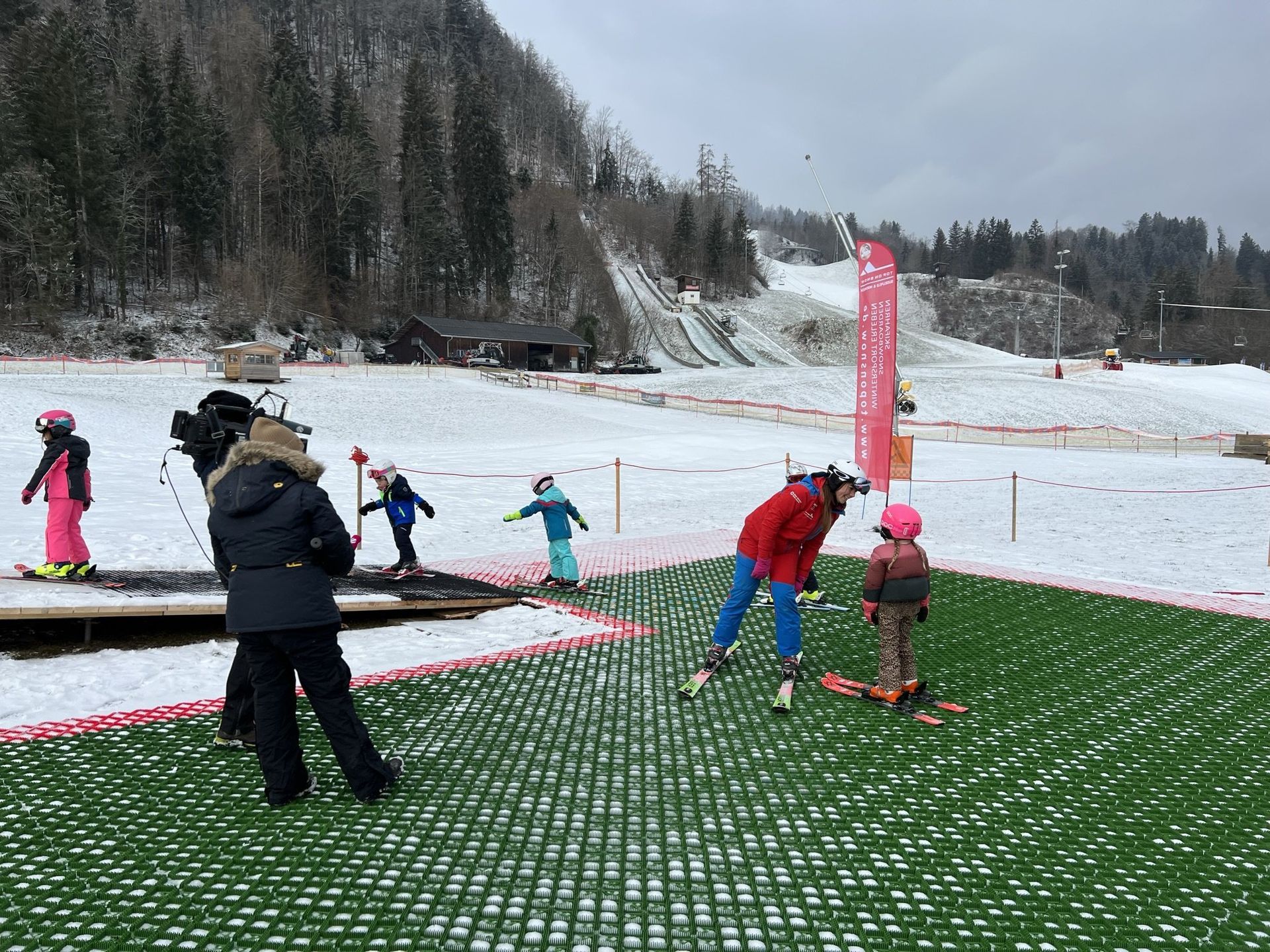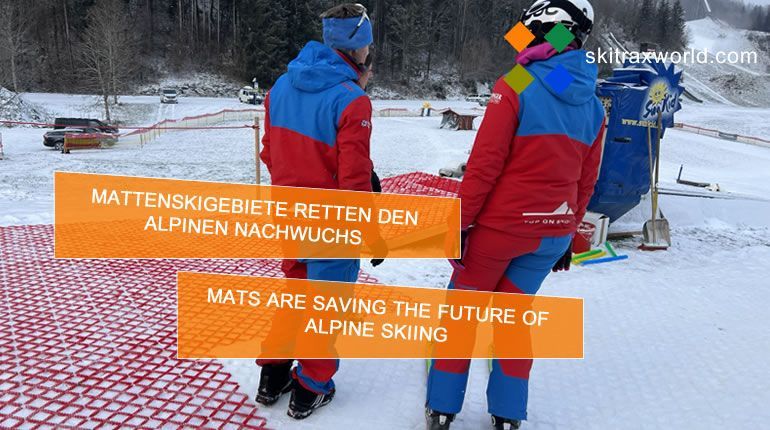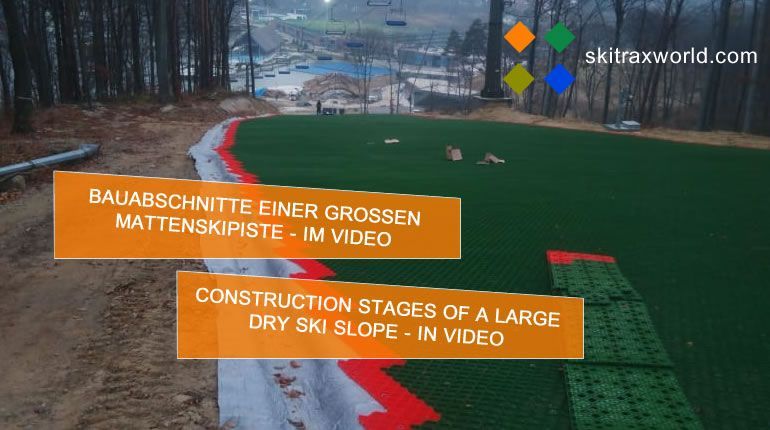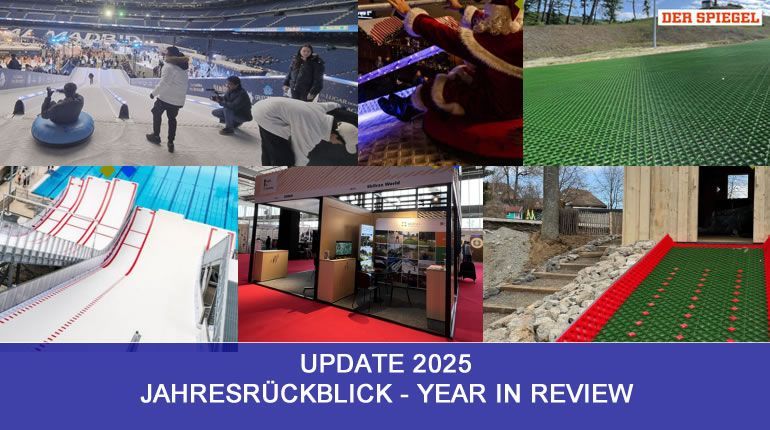Snow of tomorrow
Sueddeutsche Zeitung gives it some thought
In the weekend edition of the "Sueddeutsche Zeitung" (German Newspaper) of 2023, March 11th, the editorial staff thought about the use of mats as an alternative to the lack of snow. In a long interview, Skitrax World GF Wolfgang Schmidt was able to explain that this alternative basically has a positive influence on learning and practising skiing.
Because there is a rumbling at the base of the alpine winter sport. 4000 ski clubs in Germany see a declining interest in alpine skiing. The number of active young skiers is falling rapidly. Ski schools complain about a lack of children for beginners' courses. There is a lack of breadth. The reasons are the lack of snow in the established ski resorts, the high costs of travelling to the ski resorts and the negative CO2 balance of the long journey from the north to the Alps. In addition, glacier training is cancelled because most glaciers are closed from spring to autumn.
Fewer and fewer people want to learn how to ski. How is the downward trend to be stopped? The alternative is there - it just needs to be used creatively!
There is also a very informative online edition to accompany the article in the "Sport am Wochenende" issue (2023, March 11):
Ski on mats and plastic: what alternatives are there for snow? - SZ.de (sueddeutsche.de)
Text excerpt: Süddeutsche Zeitung, weekend edition: March 11, 2023
Snow of tomorrow
"Soon it will also be too warm in many places in the Alps to make artificial snow on the slopes in winter. And then? Alternatives are already in use: About skiing on brushes, waves and spaghetti made of plastic
BY KORBINIAN EISENBERGER
Yesterday's snow had already dwindled considerably, and so they made a decision at the Hocheck ski resort near Oberaudorf. Because there was only a greyish remnant of old snow left on the ski slope, they started a pilot project: the lift operators had the slope covered with replacement snow at the end of January. More precisely: with a brush-like construction made of plastic, 80 by eight metres wide.
But do people want to ski on it?
The people of Oberaudorf are something like pioneers of a new art movement. The art is to create snow without using guns. In the Alps, the procedure with plastic mats is not yet very widespread, alternative snow will be very hard to find there. The "Erlebnisberg Oberaudorf-Hocheck" in the Inn Valley is the first ski resort in Bavaria to try it out.
There was no need for snowcats; the slope in Oberaudorf was prepared by a man who has been working with alternative snow for 15 years. Wolfgang Schmidt is at home in Oberaudorf and founded a company there that now supplies plastic ski slopes for five continents. In Santiago de Chile, people now ski on mats from Oberaudorf, in Mumbai too; in Coorg, southern India, a larger installation is under construction. One of the smallest has recently been located within sight of the Skitrax company premises.
Wolfgang Schmidt is the company's managing director and thus its top salesman. But he is also a state-certified ski instructor, the father of the former ski cross World Cup racer Florian Schmidt - and a ski enthusiast for as long as he can remember. He would have preferred never to have had to worry about plastic snow. But things just happened the way they did.
The 67-year-old still remembers the Zugspitze when there was five metres of snow there in winter. Now it's maybe one more. In Courchevel, France, where the Alpine World Championships recently took place, he once entered the ski hotel through the first floor, that's how high the snow mountains were piled up. And now? "At the World Championships, they made all the snow there," he says. "The southern slopes were all green."
In 2008, Schmidt took this development as an opportunity to look into artificial snow. When it comes to the production of alternative snow, Schmidt's company is one of the global players. Thousands of square metres of Skitrax mats have been delivered from Oberaudorf all over the world, not only in India and Chile, but also in the USA, New Zealand, Australia, Great Britain and the Netherlands. Schmidt completed his most extensive project to date - even before the Russian war of aggression began - in Ukraine. Since then, Lviv has been home to the largest dry slope ski area in the world, covering 19,000 square metres. In a promotional video of the "Emily" ski resort, cocktails can be seen being sipped at the swimming pool in the valley, while in the background adults and children are winding down a 600-metre green run. It looks like a scene from a science fiction film.
But that's exactly how things are going there, in western Ukraine. Despite the war, there are guests there at the moment.
There are bigger problems than skiers finding no more natural snow. And yet this sport is one of the clearest examples of the consequences of global warming for ski tourists, lift operators, hoteliers - and for the professional winter sports scene. The biathletes were able to pull off their World Cup calendar by the skin of their teeth, but the pictures were grotesque; miraculously, the cross-country ski trail builders in Ruhpolding managed to model a white band in the green landscape. The alpine athletes are used to cancellations by now; this season all World Cup races in Zermatt-Cervinia (Switzerland) and Lech-Zürs (Austria) were cancelled due to lack of snow. And the ski jumpers landed on green plastic for the first time in a Winter World Cup in Wisla (Poland).
Once there was hardly any snow to be had in winter in all these regions, but now spring fever sometimes sets in. For weeks it was clearly too warm to even think about making artificial snow. So: artificial snow from frozen water. This was also noticeable in the Inn Valley. Nevertheless, groups of skiers were regularly seen skiing down the slopes in Oberaudorf. Carving is not possible there, but swinging is. "The feeling on the slopes is different than on snow," says Hannes Rechenauer from the Hocheck Mountain ski resort in Oberaudorf. But at least it feels like skiing at all.
Rechenauer had recently noticed a noticeable decline in young skiers, for example among schoolchildren who come to Oberaudorf from Munich by regional train. Twenty years ago, he says, about half of a class could ski. "Now, with 30 children, there are maybe seven or eight left." Without guaranteed snow, there's no ski camp. "Then the teachers say they'd rather go to the zoo."
No one in the Alps can offer snow safety that easily any more. Rechenauer now at least offers skiing safety. Significantly more than half of the CO₂ emissions from skiing are caused by the ever longer journey by car, for example to glacier regions. For many people, this is also an issue. Rechenauer, at any rate, is now apparently more popular than he himself expected. "I'm surprised how well people have taken to it," he says. "Children and beginners see it as a good alternative."
In Bavaria, the whole thing is a first. In England and the Netherlands, meanwhile, people have been learning and practising on substitute snow for decades. The most prominent example of such an alternative career start is Britain's Dave Ryding. Until the age of twelve, the slalom specialist trained and competed exclusively on mat slopes before he competed in a race on snow for the first time. In the meantime, Ryding is 36 years old and can call himself a World Cup winner; in 2022 he won the slalom classic in Kitzbühel, which is of course held on snow. Still?
In Austria, the Oberaudorf project has been reported quite excitedly; alternative snow has so far had a place there, if at all, at the lift entrance, or sporadically on drag lift tracks with heavy snowmaking. In the Alpine regions, people generally have a hard time with the idea of skiing on artificial slopes. In the ski country of Bavaria, anyway. The Bayerische Zugspitzbahn explains that they have never thought about mats before. "We don't see it as an alternative to snow." The Association of German Cable Cars also sees no trend: "The real winter business is skiing on snow, outside in nature, in the fresh air and in front of a mountain panorama."
If you ask professionals in the Alpine ski circus about alternatives for their melting white, they usually react like Romed Baumann at a fireside chat during the Ski World Cup in Val Gardena/Gröden in December. Racing on mats? Ever tried it? "No, absolutely not," explained the Austrian, who competes for the German Ski Association (DSV). Once he hopped down a summer ski jump, says Baumann: "That was my only contact with mats."
Christian Schwaiger, head men's coach at the DSV (Germany Ski Assoziation), once worked for ten years as a coach in England - the motherland of dry slope skiing - had closer contact with the subject. Schwaiger does not sound like a fan. "Laying the foundation on the mats and then going to the World Cup, that doesn't work like that," he explains at a meeting. He does not consider Dave Ryding's success story to be representative. "Ryding is the only one who trained a lot on mats and made it." All the other island exotics who established themselves in the World Cup, such as the Scots Alain Baxter or Finlay Mickel, had moved to mainland Europe early on in order to break into the world's best in the Alps - on real snow - he said. "They had their homes in Courchevel."
It's nice to have that opportunity! But: what happens when it will be possible to make snow at fewer and fewer winter sports resorts? Is the future of skiing green then? Are brushes the new snow? And: do people really want them lying around in their mountains?
Concerns are not only being voiced by the World Cup pros. The Bavarian nature conservation organisation Bund Naturschutz recently predicted "ecological problems" from the use of plastic mats on slopes. It is to be assumed, for example, that the ski edges cause abrasion that ends up as microplastics in the meadows. In Oberaudorf, they counter that a special felt underlay including a drainage system prevents this scenario. There is also a debate about whether people injure themselves more quickly on plastic mats than on snow - although it is difficult to make general comparisons here. There are such and such snow conditions. And the alternative snow products are also diverse.
What most products on the market have in common is that they can be skied on with standard skis. Nevertheless, there are differences. Skitrax from Upper Bavaria, for example, offers one of the smallest variants: The modules are 22×22 cm and are put together like a puzzle with short knobs to form a brush-like surface . . . ."
"The fact that we cannot do without mats is of course more than unromantic - in an ideal scenario, alternative snow would consist of an ecologically purely degradable substance that is composed of flake-like parts, which offers the same properties as snow and can be produced cheaply and climate neutrally. Snow from plants, perhaps - similar to the vegetable egg that researchers recently presented. You can easily bang it in the pan and watch the egg white, which is not an egg white, curdle around the yellow yolk, which is not an egg yolk. But there is no such thing as beaten egg whites. And there probably never will be.
In the search for a snow substitute, one will probably always end up with a cohesive, much less flexible substance. Exceptions are, at most, ski hills made of sand, such as the "Monte Kaolino" near Hirschau in the Upper Palatinate, a 120-metre-high hill made of 33 million tonnes of the finest quartz sand. The slope is 200 metres long and quite steep with a gradient of 40 degrees, which is conducive to progress. The fact that this is the only sand skiing area in Europe (and the only one in the world with a stationary lift) suggests that sand skiing will not become widespread.
So it's back to mountains of mats after all? . . . . . "
"The Oberaudorf brush runway now has a special function: tilt rods can be screwed between the plug-in modules."
Source: Sueddeutsche Zeitung, weekend edition March 11, 2023
UPDATE - Berichte von anderen Installationen









